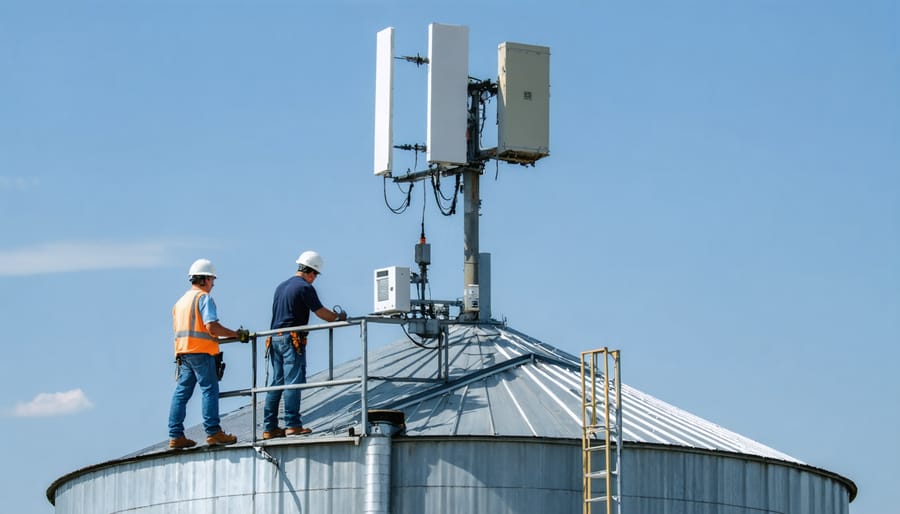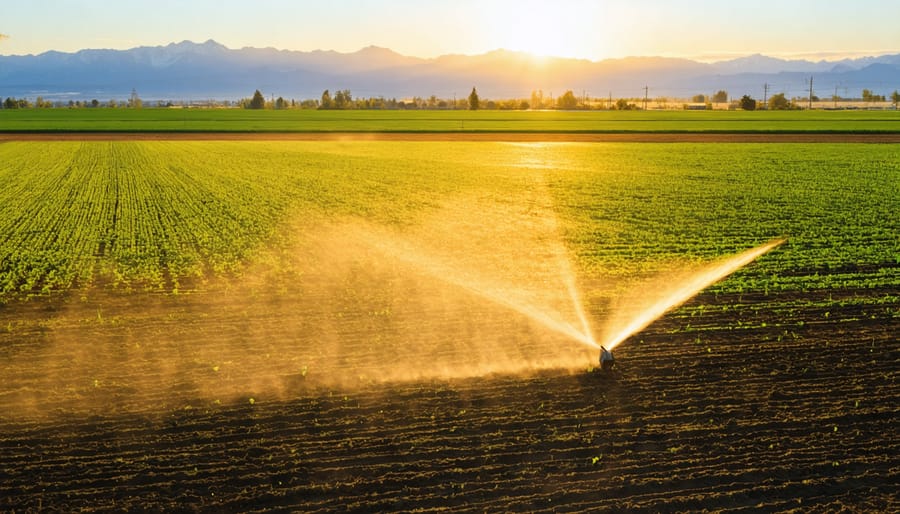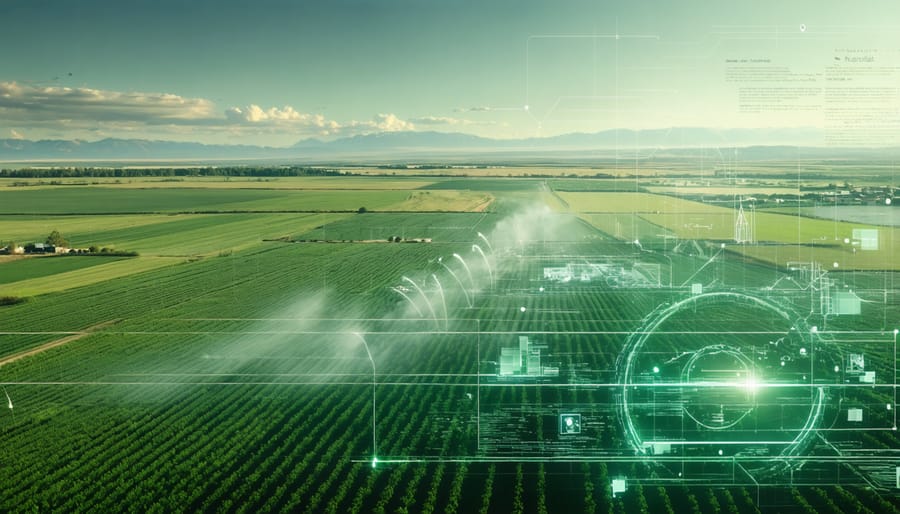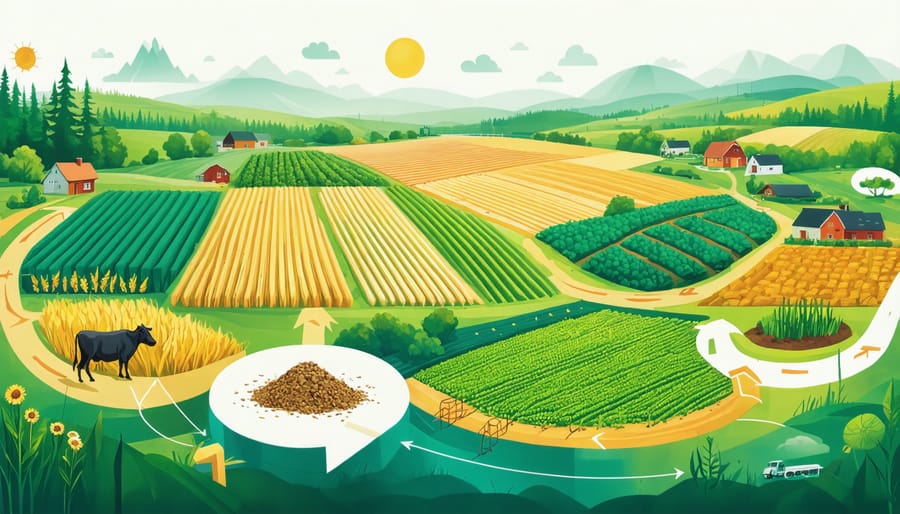In the heart of rural Alberta, a digital revolution unfolds unevenly across the landscape. While urban centers buzz with high-speed connectivity, nearly 30% of Canadian rural households still lack reliable broadband access, creating a stark divide that impacts everything from precision agriculture to online education. This gap isn’t just about internet speeds – it’s about economic survival, educational opportunities, and the future viability of farming communities.
For fifth-generation farmer Sarah Thompson, who runs a 2,000-hectare operation near Peace River, the consequences are immediate and tangible. “Without reliable internet, we can’t access real-time market data, operate smart farming equipment, or participate in virtual agricultural training,” she explains. “We’re essentially farming with one hand tied behind our backs.”
The digital divide represents more than a technological challenge; it’s a critical infrastructure issue that threatens the competitiveness of Canadian agriculture. As urban areas surge ahead with 5G networks and smart city initiatives, rural communities risk falling further behind – not just in connectivity, but in their ability to adopt innovative farming practices, access telehealth services, and maintain vibrant, connected communities for the next generation of agricultural leaders.
This moment calls for urgent action, strategic investment, and a renewed commitment to digital equity in rural Canada.

The Real Cost of Poor Connectivity in Rural Alberta
Missed Opportunities in Smart Farming
The rapid advancement of smart farming technologies has created a stark divide between connected and underserved rural areas. Many Alberta farmers are missing out on crucial innovations that could revolutionize their operations. Precision agriculture tools, which can optimize irrigation and reduce input costs by up to 20%, remain inaccessible to those without reliable internet connectivity.
Real-time weather monitoring systems and soil sensors, which have shown to increase crop yields by 15% in connected regions, stay out of reach for many family farms. Remote equipment monitoring and predictive maintenance capabilities, which can prevent costly breakdowns during critical harvest periods, require bandwidth that many rural areas simply don’t have.
The inability to access cloud-based farm management systems means many producers are still relying on manual record-keeping, limiting their ability to make data-driven decisions. Additionally, opportunities for direct-to-consumer marketing through digital platforms and participation in virtual farming communities remain untapped, preventing farmers from diversifying their income streams and sharing valuable knowledge with peers.
Market Access Limitations
Limited internet connectivity significantly impacts rural farmers’ ability to participate in modern e-commerce and access broader market opportunities. In Alberta, many agricultural producers struggle to list their products on online marketplaces or engage with potential buyers through digital platforms due to unreliable internet connections.
For instance, real-time grain price monitoring, which has become essential for competitive selling, becomes challenging when farmers can’t maintain stable internet connections. Local producers often miss opportunities to secure better prices or connect with new buyers simply because they can’t access online trading platforms effectively.
The situation also affects farmers’ ability to participate in virtual farmers’ markets and direct-to-consumer sales platforms, which became particularly crucial during recent years. Many Alberta farmers report frustration with upload speeds that make it impossible to share product photos or maintain e-commerce websites, limiting their reach to urban consumers seeking local food options.
Additionally, poor connectivity hampers farmers’ participation in online agricultural training programs and virtual networking events, which could help them discover new market opportunities and business strategies. This creates a cyclical problem where limited internet access leads to reduced market knowledge, resulting in fewer economic opportunities for rural communities.
Success Stories: Digital Solutions That Work
Community-Led Internet Projects
Across rural Alberta, communities are taking connectivity into their own hands through innovative grassroots initiatives. The Olds Institute’s O-NET project stands as a pioneering example, where local farmers and residents collaborated to build their own fiber-optic network, delivering high-speed internet to previously underserved areas. This successful model of rural-urban digital collaboration has inspired similar projects throughout the province.
In Mountain View County, a group of agricultural producers formed a cooperative to share resources and establish a wireless mesh network, connecting multiple farms and homesteads. This community-driven approach not only reduced installation costs but also ensured ongoing maintenance through shared responsibility.
The Peace Region Internet Society demonstrates another successful model, where farmers, Indigenous communities, and local businesses joined forces to create a sustainable internet infrastructure. Their network now serves over 2,000 rural households, supporting precision agriculture practices and online market access.
These initiatives often combine traditional barnraising principles with modern technology solutions. Local knowledge sharing sessions, volunteer technical support teams, and cooperative funding models have proven essential to their success. Many communities have also partnered with established internet service providers, creating hybrid solutions that benefit from both local expertise and professional technical support.

Innovative Offline Solutions
Despite connectivity challenges, Alberta’s farming community has developed resourceful ways to maintain productivity and efficiency. Many farmers have implemented offline-capable apps that sync when internet access becomes available, allowing them to record field data, track livestock, and manage inventory without constant connectivity.
Local agricultural cooperatives have established data-sharing hubs where farmers can download essential weather forecasts, market prices, and agricultural bulletins to USB drives for offline access. Some innovative producers have created local mesh networks, connecting nearby farms to share resources and information without relying on traditional internet infrastructure.
The Prairie Agricultural Machinery Institute has pioneered offline GPS systems for precision farming, enabling tractors and equipment to operate with stored mapping data. These systems can work for several days without needing to reconnect to satellites or the internet.
Several communities have converted grain elevators into local digital stations, equipped with high-speed internet and computing facilities. Farmers can visit these stations to download updates, submit documentation, and sync their farm management software.
Mobile data storage solutions have become increasingly popular, with many farmers using portable hard drives to transfer large datasets between locations. Some have even repurposed old smartphones as offline data collection devices, using them to photograph crop conditions, record soil readings, and document equipment maintenance needs.
These practical workarounds demonstrate the resilience and adaptability of rural communities in maintaining modern farming practices despite infrastructure limitations.
Practical Steps for Rural Digital Integration
Assessment and Planning
Conducting a thorough assessment of your farm’s digital needs begins with mapping out current internet connectivity, identifying technological gaps, and understanding how improved digital access could benefit your operations. Start by documenting your daily digital requirements, from checking weather forecasts to managing equipment monitoring systems.
Create a detailed inventory of your existing digital infrastructure, including internet speeds, cellular coverage, and available devices. Consider surveying family members and farm workers about their digital needs and pain points. This information helps build a comprehensive picture of where improvements are most needed.
When planning improvements, work with local internet service providers to understand available options and potential upgrade paths. Many Alberta farmers have found success by partnering with neighbouring farms to share costs and resources for infrastructure improvements. Consider forming or joining a local broadband committee to advocate for better services in your area.
Set realistic timelines and budgets for digital improvements, prioritizing essential services first. Remember to factor in training needs for new technology adoption. The Alberta Agriculture and Forestry department offers resources and guidance for digital planning, including assessment tools specifically designed for farm operations.
Track your progress using measurable benchmarks, such as download speeds, digital task completion times, and productivity improvements. Regular reassessment ensures your digital strategy evolves with your farm’s changing needs and technological advancements.
Available Resources and Support
Several government programs and resources are available to help Alberta’s rural communities bridge the digital divide. The Universal Broadband Fund, launched by the Canadian government, provides substantial support for high-speed internet infrastructure development. Through rural digital funding initiatives, local farmers can access grants for technology adoption and digital skills training.
The Alberta Rural Development Network offers technical assistance and community planning support, helping agricultural communities identify their connectivity needs and develop practical solutions. Their Digital Literacy Program provides hands-on training sessions specifically designed for farmers and rural business owners.
Local libraries and community centers across Alberta have stepped up as digital hubs, offering free internet access, computer workstations, and basic digital skills workshops. The Mobile Internet Lab program brings connectivity solutions directly to remote farming communities through travelling tech support units.
The Canadian Agricultural Partnership also provides funding for digital agriculture projects, including precision farming technology adoption and farm management software implementation. Additionally, several telecommunications companies offer special rural connectivity packages with flexible payment options and technical support tailored to agricultural needs.
For immediate assistance, farmers can contact their local Agricultural Service Board or visit their nearest Rural Alberta Service Centre, where dedicated staff can help navigate available resources and funding opportunities.
Building Digital Skills
Building digital skills in rural Alberta has become more accessible through various community-driven initiatives and programs. Local libraries across the province offer free basic computer courses, while agricultural extension offices provide specialized workshops focused on digital farm management tools and precision agriculture technologies.
The Alberta Digital Farm Initiative, launched in partnership with local agricultural societies, delivers hands-on training sessions where farmers can learn essential digital skills, from using farm management software to operating GPS-guided equipment. These sessions are typically held during off-peak farming seasons to ensure maximum participation.
Online learning platforms have also adapted to rural needs, with many offering downloadable content that can be accessed offline. The Canadian Agricultural Skills Service provides self-paced courses specifically designed for farmers, covering topics like digital record-keeping, online marketing, and e-commerce basics for farm products.
For those seeking more personalized support, many agricultural equipment dealers now offer one-on-one training sessions when implementing new digital technologies. Additionally, mentor programs pair tech-savvy farmers with those looking to enhance their digital capabilities, creating valuable knowledge-sharing networks within the farming community.
Local agricultural colleges have expanded their continuing education programs to include digital literacy courses, often offering evening and weekend classes to accommodate farming schedules. These programs focus on practical applications, ensuring farmers can immediately apply their new skills to improve farm operations.
Future-Proofing Rural Connectivity
Upcoming Infrastructure Projects
Several transformative infrastructure projects are set to reshape rural Alberta’s digital landscape in the coming years. The Universal Broadband Fund is supporting a major fiber-optic network expansion that will connect over 50,000 rural households by 2025. In partnership with local internet service providers, the Alberta Rural Connectivity Coalition has secured funding for 15 new cellular towers across central and northern regions, significantly improving coverage for farming communities.
The SuperNet Enhancement Project, scheduled to begin next spring, will upgrade existing infrastructure to provide speeds up to 100 Mbps for remote areas. This initiative specifically targets agricultural regions where precision farming technologies require reliable connectivity. Additionally, the Rural Municipality Broadband Partnership Program is launching pilot projects in five counties, implementing innovative solutions like fixed wireless access points on grain elevators and other tall agricultural structures.
These projects demonstrate a coordinated effort between federal, provincial, and local governments to bridge the digital divide. The planned improvements will enable farmers to fully leverage smart farming technologies while ensuring rural communities remain competitive in an increasingly digital agricultural landscape.
Preparing for Tomorrow’s Technology
As technology continues to evolve, preparing for tomorrow’s digital landscape is crucial for rural farmers. Start by conducting a thorough assessment of your current technology infrastructure and identifying potential areas for improvement. Consider forming smart tech partnerships with local agricultural organizations and tech providers to stay ahead of innovations.
Invest in basic digital literacy training for yourself and your staff. Many Alberta agricultural colleges offer flexible online courses designed specifically for busy farmers. Create a technology adoption roadmap that outlines gradual implementations over the next three to five years, focusing on solutions that offer the best return on investment for your specific operation.
Consider setting aside a small portion of your annual budget for technology upgrades and training. Start with essential tools like reliable internet connectivity and basic farm management software, then gradually expand to more advanced solutions as your comfort level grows.
Join local farming technology groups or online communities where you can share experiences and learn from peers who are on similar digital transformation journeys. Remember, preparing for tomorrow’s technology isn’t about implementing everything at once – it’s about making strategic choices that will benefit your farm’s long-term sustainability.

The digital divide in rural Alberta presents both significant challenges and promising opportunities for our farming communities. Throughout this discussion, we’ve explored how limited internet access impacts agricultural operations, from precision farming to market access and educational opportunities. However, we’ve also seen inspiring examples of communities coming together to bridge this gap, implementing innovative solutions that work for their unique circumstances.
As we look to the future, it’s clear that addressing the digital divide requires a multi-faceted approach involving government support, private sector investment, and community participation. Success stories from regions like Olds, Alberta, demonstrate that rural communities can achieve robust digital connectivity when stakeholders work together with clear goals and determined effort.
The path forward demands active engagement from all of us in the agricultural community. Whether it’s participating in local broadband initiatives, sharing resources with neighbouring farms, or advocating for improved infrastructure, every action contributes to strengthening our digital foundation. Remember, enhancing connectivity isn’t just about faster internet—it’s about ensuring the sustainability and prosperity of rural Canadian agriculture for generations to come.
By staying informed, supporting local initiatives, and embracing available technologies while pushing for better solutions, we can work together to close the digital gap. The future of farming depends on our ability to stay connected, competitive, and innovative in an increasingly digital world.










